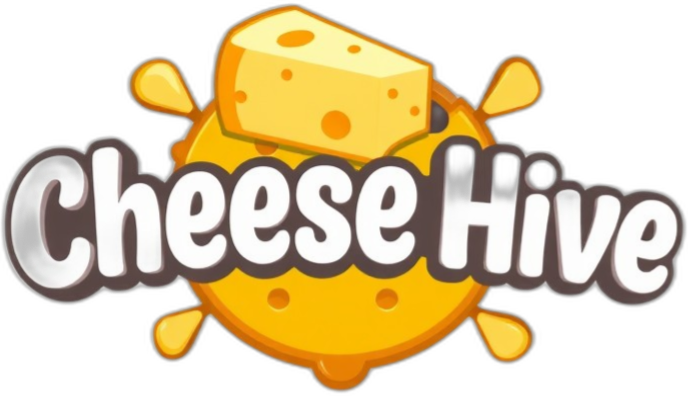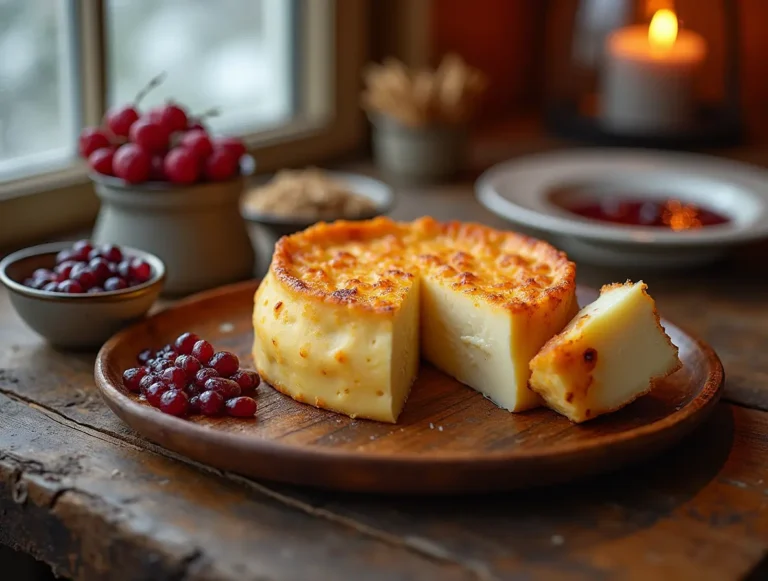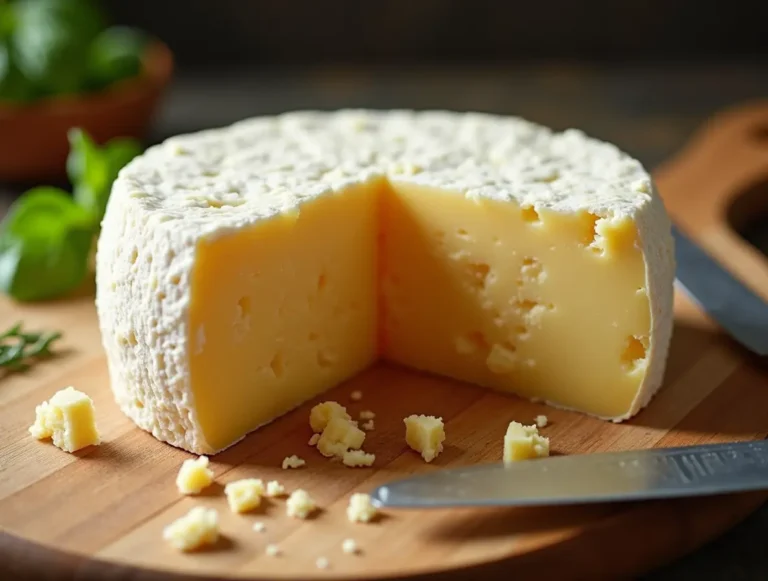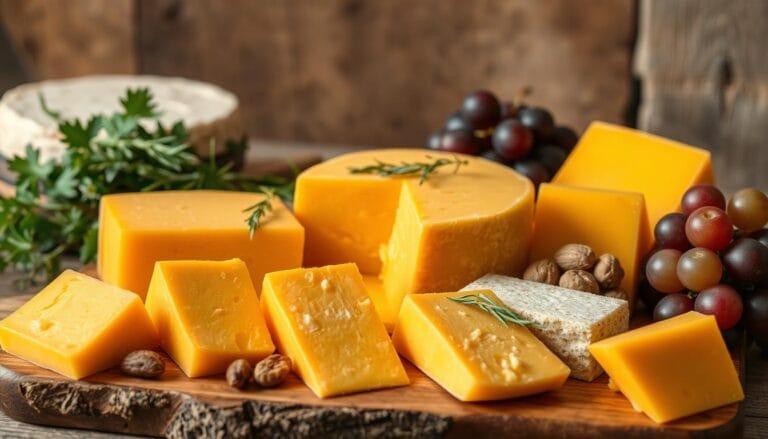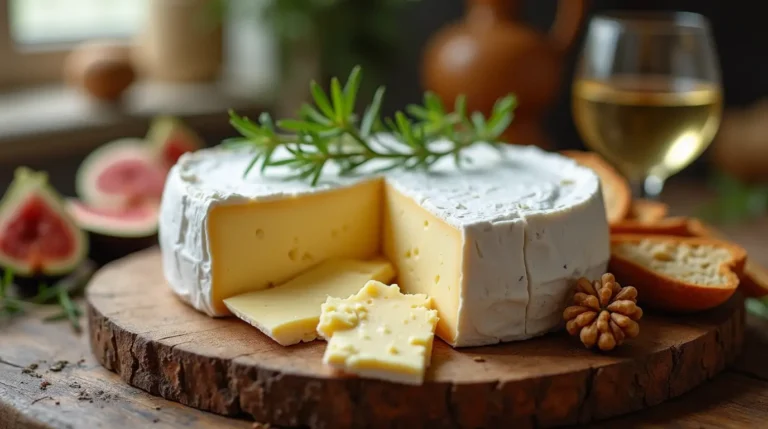Pepper Jack Cheese: A Bold and Creamy Spicy Delight!
I love cheese, and pepper jack is my favorite. Growing up in the United States, I was always drawn to its bold flavors. The smell of pepper jack cheese would fill the air, making me want to try it.
It was amazing on burgers or in casseroles. Pepper jack makes any dish special. It adds a spicy and creamy touch that’s hard to resist.
Table of Contents
What is Pepper Jack Cheese?
A Fiery Fusion of Flavors
Pepper jack cheese is a semi-soft cheese made from cow’s milk. It started in the United States. It combines creamy Monterey Jack cheese with spicy peppers like jalapeños and habaneros.
This mix creates a cheese with a spicy kick and a smooth texture. It’s known for its bold, robust flavor that adds heat to many dishes.
The spiciness can vary. Some cheeses have a mild kick, while others are hotter. The fiery fusion of flavors in pepper jack cheese makes it special and loved by many.
“Pepper jack is a semi-soft, cow’s milk cheese that originated in the United States. It’s made by blending the creamy and mild Monterey Jack cheese with a variety of spicy peppers, such as jalapeños, habaneros, and serrano peppers.”
Monterey Jack cheese, the base, has a mild, buttery taste. Adding spicy peppers gives pepper jack a tangy spiciness. This makes it great for many dishes, like quesadillas, nachos, sandwiches, and salads.
The History of Pepper Jack
The story of pepper jack cheese starts in the southwestern United States. Cheesemakers there mixed their cheese with spicy peppers. This mix-up happened in the late 20th century, making a new version of Monterey Jack cheese.
Monterey Jack cheese has been around since the late 18th century. It was first made by Spanish Franciscan priest Junipero Serra in 1769. By 1859, it was sold in Monterey for over $1,000.
David Jacks, a big landowner, was linked to the cheese in the early 20th century. It was named “Monterey Jack” in his honor. Since the 1950s, Monterey Jack has been mixed with other cheeses, like pepper jack.
As spicy foods became more popular, cheesemakers added peppers to Monterey Jack. They used jalapeño, habanero, and even ghost pepper. This made a cheese that was creamy, tangy, and spicy.
Now, pepper jack cheese is loved everywhere in the U.S. Wisconsin leads in making spicy cheese hybrids. The heat level can vary, from mild to very spicy. Its popularity keeps growing as people look for bold cheeses to use in cooking and snacks.
| Year | Event |
|---|---|
| 1769 | Spanish Franciscan priest Junipero Serra founded the first California Catholic mission. |
| 1859 | Monterey was sold for $1,000.02 in a last-minute auction, mainly attended by Delos R. Ashley and David Jacks. |
| 1909 | David Jacks passed away, leaving behind a vast estate that included around 60,000 acres of land. |
| 1955 | The Food and Drug Administration officially named the cheese “Monterey Jack.” |
Pepper Jack Cheese Varieties
Jack Pepper cheese is a versatile and flavorful variety. It comes in a wide range of spice levels and flavor profiles. From mild to wild, this cheese offers something for every palate.
Mild Pepper Jack
For those who prefer a subtle heat, mild pepper jack is the way to go. Made with milder peppers like Anaheim or New Mexico chiles, this variety has a gentle warmth. It also has a creamy, smooth texture that melts beautifully.
Spicy Pepper Jack
On the other end of the spectrum, spicy pepper jack packs a significant punch of heat and spice. Infused with hotter peppers like jalapeños or habaneros, this variety is perfect for those who crave a fiery kick.
Garlic Pepper Jack
For an extra layer of flavor, some jack pepper cheeses are blended with garlic. The combination of spicy peppers and fragrant garlic creates a delightfully complex taste experience.
Herb-Infused Pepper Jack
Certain versions of pepper jack are enhanced with the addition of fresh herbs like rosemary, thyme, or basil. These herb-infused varieties offer a more nuanced flavor profile. They complement the spicy notes of the peppers.
| Pepper Jack Cheese Variety | Spice Level | Flavor Notes |
|---|---|---|
| Mild Pepper Jack | Gentle Heat | Creamy, Smooth |
| Spicy Pepper Jack | Fiery Kick | Bold, Intense |
| Garlic Pepper Jack | Moderate Heat | Savory, Fragrant |
| Herb-Infused Pepper Jack | Mild to Moderate | Complex, Nuanced |
With so many options to choose from, there’s a pepper jack cheese perfect for every taste preference and culinary application.
How Pepper Jack is Made
Pepper jack cheese is a semi-soft, spicy cheese. It combines the creamy texture of Monterey Jack with the fiery kick of various peppers. The production process involves several key steps that bring out its unique characteristics.
The journey starts with curdling the milk. Rennet, an enzyme from young ruminants’ stomachs, is added to cow’s milk. This separates the curds (solids) from the whey (liquid). The curds are then cut into smaller pieces and gently heated to remove more whey.
Next, salt is added to the curds. The mixture is pressed into blocks to reduce moisture content. This stage is when the cheese starts to develop its texture and flavor.
- Curdling the milk: Rennet is added to cow’s milk to separate the curds (solids) from the whey (liquid).
- Cutting and cooking the curds: The curds are cut into smaller pieces and heated to remove more whey.
- Salting and pressing: Salt is added to the curds, and the mixture is pressed into blocks to remove additional moisture.
- Aging: The blocks of cheese are aged for several weeks to a few months, during which time the characteristic pepper jack flavor develops.
- Infusing with peppers: During the aging process, a blend of spicy peppers is incorporated into the cheese, creating the signature pepper jack flavor.
The final step is the infusion of spicy peppers. As the cheese ages, a blend of peppers like jalapeños, habaneros, or serranos is added. This infusion of heat and flavor makes pepper jack unique compared to Monterey Jack.
| Ingredient | Quantity |
|---|---|
| Cow’s Milk | Varying amounts |
| Rennet | Enough to curdle the milk |
| Salt | Enough to season the curds |
| Spicy Peppers | Varying blend and quantities |

“The key to making a great pepper jack cheese is finding the perfect balance of creaminess and heat. It’s a delicate dance that takes time and precision to master.”
Pepper Jack Cheese Nutritional Value
Pepper jack is not just tasty; it’s also packed with nutrients. A single ounce of this spicy cheese is a nutritional powerhouse.
One ounce of pepper jack cheese has 117 calories, 9 grams of fat, and 7 grams of protein. It’s also a good source of calcium, offering 204 milligrams. This is 20% of the daily recommended intake.
| Nutrient | Amount per 1 oz serving |
|---|---|
| Calories | 117 |
| Fat | 9 g |
| Protein | 7 g |
| Calcium | 204 mg (20% DV) |
| Sodium | 333 mg |
Pepper jack cheese is also rich in vitamins and minerals. It has vitamin A, vitamin B12, and phosphorus. But, it’s high in sodium. So, it’s best to enjoy it in moderation as part of a healthy diet.
“Cheese is one of the most perfect foods. It provides protein, calcium, and a range of other essential nutrients.”
Pepper Jack Cheese Pairings
Complementing the Spicy Kick
Pepper jack cheese’s bold, spicy flavor is perfect with many foods and drinks. It’s great for balancing the heat or adding creaminess. There are lots of tasty ways to pair pepper jack cheese.
For a savory contrast, try it with cured meats like salami, prosciutto, or pepperoni. The cheese’s creaminess also goes well with crunchy crackers or crusty bread.
To cool down the spice, fresh fruits like apples, grapes, or pears are sweet and refreshing. Pairing pepper jack with bold red wines or crisp white wines is also a great choice.
Beer lovers will enjoy pepper jack with hoppy, flavorful brews. The beer’s carbonation and bitterness cut through the cheese’s richness.
“The versatility of pepper jack cheese allows it to shine in a wide range of culinary applications, from charcuterie boards to hot sandwiches and beyond.”
Looking to impress with a cheese plate or add spice to your dishes? Pepper jack cheese is full of possibilities. Pair it with the right foods and drinks to discover delicious flavors.
Cooking with Pepper Jack Cheese
Pepper jack cheese is a versatile ingredient that can add a flavorful twist to a variety of dishes. It’s great in savory sandwiches, burgers, creamy pasta bakes, and spicy breakfast scrambles. This cheese offers a delightful balance of creaminess and heat. Explore the many ways to incorporate pepper jack cheese into your cooking and elevate your meals with its unique blend of flavors.
Sandwiches and Burgers
Pepper jack cheese is a fantastic addition to grilled cheese sandwiches, adding a spicy kick to the creamy goodness. It also pairs beautifully with juicy burgers, melting seamlessly to create a mouthwatering flavor profile.
Dips and Spreads
The creamy texture of pepper jack cheese makes it an excellent choice for hot artichoke dips, cheese balls, and other savory appetizer spreads. Its subtle heat complements the richness of the other ingredients, creating a delectable balance of flavors.
Pasta Dishes
Pepper jack cheese melts beautifully into pasta dishes, such as mac and cheese, lasagna, and baked pasta casseroles. It adds a spicy twist to these comfort food favorites, infusing them with a unique and satisfying flavor.
Omelets and Scrambles
Sprinkle pepper jack cheese on top of or mix it into egg dishes like omelets and scrambles for a flavorful breakfast. The cheese’s spicy notes complement the fluffy eggs perfectly.
Pizzas and Flatbreads
Pepper jack cheese is a fantastic topping for spicy pizzas, flatbreads, and calzones, adding a kick of flavor that takes these dishes to the next level.
Explore the versatility of pepper jack cheese and incorporate it into your cooking for a delightful touch of heat and creaminess. From sandwiches and burgers to pasta and egg dishes, this cheese can elevate a wide range of recipes.
Storing Pepper Jack
Keeping it Fresh
Keeping pepper jack cheese fresh is crucial. Here are some tips to help you store it right:
- Wrap it tightly: Use wax paper, parchment paper, or an airtight container to keep it moist.
- Refrigerate it: Keep it in the fridge for up to two months after the sell-by date if it’s unopened.
- Avoid freezing: Freezing can make pepper jack cheese crumbly, so it’s best to avoid it.
- Use resealable bags: Storing it in resealable bags keeps it fresh and prevents odors.
After opening, use it within 3 to 4 weeks for the best taste. Store it in the coldest part of the fridge, between 34°F and 38°F, to avoid foodborne illness.
By following these tips, you can enjoy your pepper jack cheese for weeks. It will stay flavorful and of high quality.
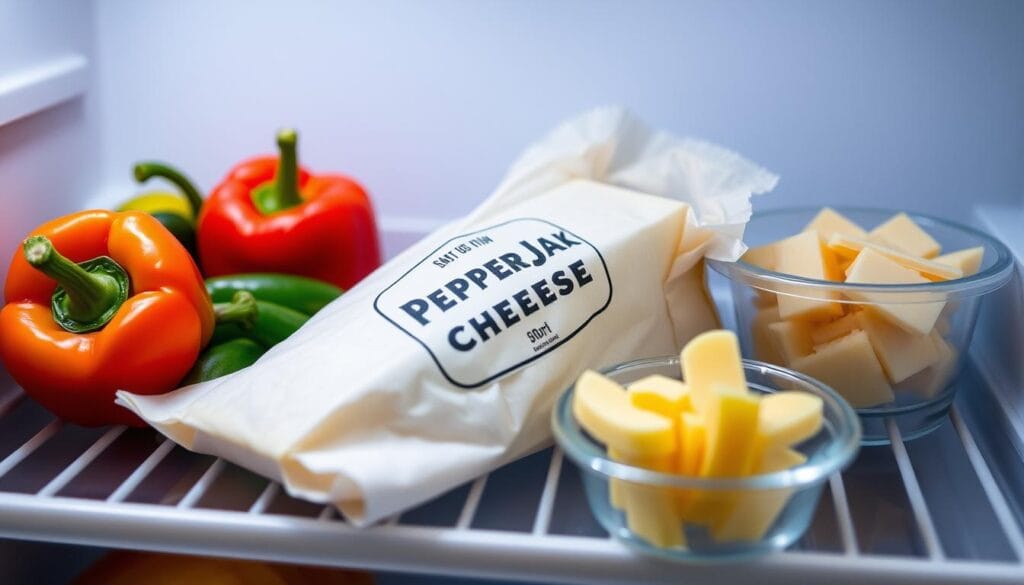
Pepper Jack Cheese Trivia
If you love pepper jack cheese, get ready for some cool facts. From its spicy start to its health benefits, pepper jack cheese is more than a tasty snack.
Did you know pepper jack cheese was born in the southwestern United States? It’s a place where spicy peppers are a big deal. The exact start of this cheese is a mystery, but it’s thought to be from the late 20th century.
Also, pepper jack cheese is semi-soft. This means it’s firmer than cheeses like brie. Its texture makes it perfect for melting.
- There’s not just one kind of pepper jack cheese. You can find it with jalapeño, habanero, serrano, or chipotle peppers.
- Pepper jack cheese is a hit in Tex-Mex and Mexican dishes. It adds a spicy flavor to favorites like quesadillas and nachos.
| Nutritional Fact | Value (per 1 oz serving) |
|---|---|
| Calories | 110-120 |
| Protein | 6-7 g |
| Calcium | 20% of daily value |
| Vitamin B12 | 10% of daily value |
Next time you enjoy pepper jack cheese, remember these fun facts. Share your cheese wisdom with friends and family!
Conclusion
Pepper Jack cheese is a unique and flavorful cheese. It’s semi-soft and has a bold, spicy kick. This cheese adds a delightful heat and creaminess to many dishes.
It’s great in sandwiches, burgers, pasta, and dips. Whether you like it milder or spicier, Pepper Jack cheese is versatile and delicious. It can spice up your cooking.
Knowing the history, varieties, and how to store Pepper Jack cheese is key. It’s rich in calcium and protein but high in fat and calories. So, enjoy it in moderation.
Pepper Jack cheese is a must-have for any home cook or cheese lover. Its unique flavor and melting properties make it essential.
In summary, Pepper Jack cheese is spicy, creamy, and versatile. It’s a favorite for many dishes. Adding it to your recipes can make meals more exciting. It also lets you explore the rich history and diverse flavors of this beloved American cheese.
FAQ
What is pepper jack cheese?
Pepper jack cheese is a semi-soft cheese from the United States. It has a bold, spicy taste and a creamy feel. It’s made by adding spicy peppers like jalapeños to Monterey Jack cheese.
What is the history of pepper jack cheese?
Pepper jack cheese started in the United States in the late 20th century. Its exact start is unknown, but it likely came from cheesemakers in the southwest. This area is known for its spicy peppers.
What are the different varieties of pepper jack cheese?
There are many types of pepper jack cheese. They range from mild to very hot. You can find mild, spicy, garlic, and herb-infused pepper jack cheese.
How is pepper jack cheese made?
Making pepper jack cheese is similar to making Monterey Jack. First, the milk is curdled. Then, the curds are cut and cooked. After that, they are salted, pressed, aged, and peppered.
What is the nutritional value of pepper jack cheese?
A 1-ounce serving of pepper jack cheese has 117 calories. It has 9 grams of fat, 7 grams of protein, and 204 milligrams of calcium. It’s also rich in vitamins A, B12, and phosphorus.
What foods pair well with pepper jack cheese?
Pepper jack cheese goes well with many foods. It pairs well with cured meats, crackers, fruits, wines, and beers. Its bold flavor complements these pairings.
How can pepper jack cheese be used in cooking?
Pepper jack cheese is great for many dishes. It’s perfect for sandwiches, dips, pasta, omelets, and pizzas. Its versatility makes it a favorite in the kitchen.
How should pepper jack cheese be stored?
To keep pepper jack cheese fresh, wrap it tightly and refrigerate it. Avoid freezing it. Proper storage keeps the cheese fresh and creamy.
